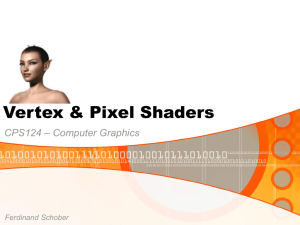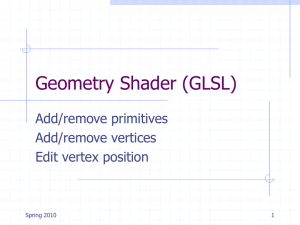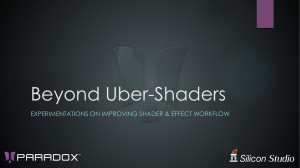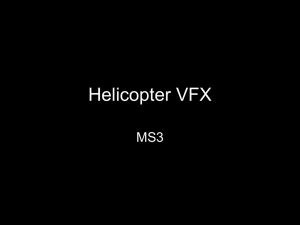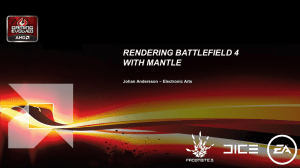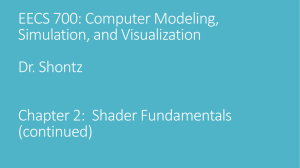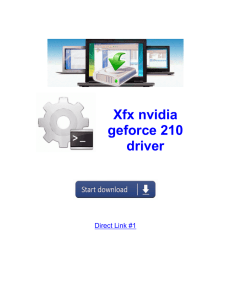Modern GPU model in the market - Computer Architecture and
advertisement
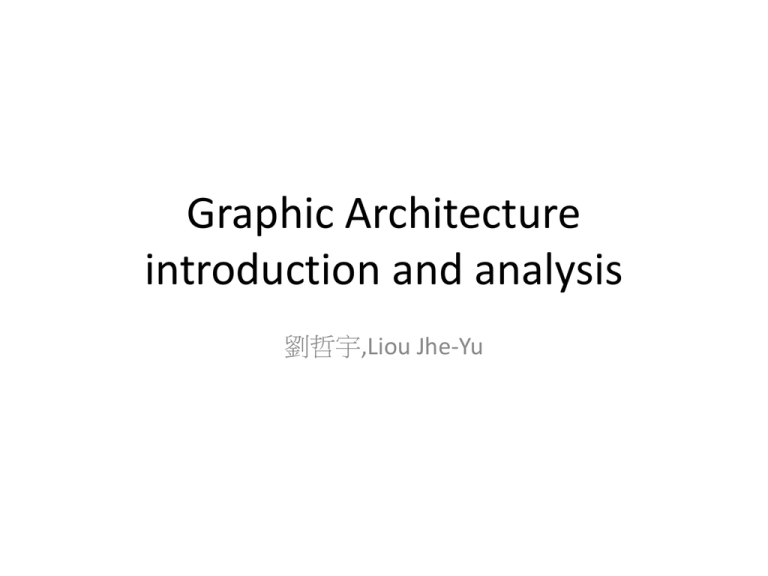
Graphic Architecture introduction and analysis 劉哲宇,Liou Jhe-Yu Outline • GPU Architecture history • Taxonomies for Parallel Rendering – Tile-based rendering • • • • Fixed function pipeline Separated shader architecture Unified shader architecture Conclusion Architecture history Silicon Graphics, Inc. • • • • 1981-2009 3D graphics accelerator in early age. Focus on high-performance graphics server. Release its own IRSI-GL API in 1992, – The first open and industrial standard – IRIS-GL -> OpenGL Architecture history From ashes • 1st generation – wireframe – transform, clip, and project – color interpolation • Model – SGI Iris 2000, 1984 Architecture history From ashes • 2nd generation – shaded solid – Lighting calculation – Depth buffer, alpha blending. • Model – SGI GTX, 1988 Architecture history From ashes • 3rd generation – Texture mapping • Model – SGI RealityEngine, 1992 Architecture history in the later time(after 2000) • Fixed function pipeline (- 2000) – With or without T&L engine • Vertex and Pixel shader (2001 - 2006) 3DMark 2000 – 4th generation • Unified shader (2007 - ) – 5th 3DMark 03 generation 3DMark 11 Architecture history Fixed pipeline production • Desktop – NVIDIA GeForce 2 - NV15 (2000) – ATI Radeon 7000 - R100 (2000) – 3dfx Voodoo3 (1999) • Acquired by NVIDIA in 2002 – S3 savage 2000 (1999) • Acquired by VIA in 2001 – Imagination STG Kyro - PowerVR3 (2001) NV GeForce 2 • Mobile – Imagination MBX - PowerVR3(2001) – ATI Imageon 130 (2002) • Sell to Qualcomm in 2009 and rename Imageon as Adreno which be integrated in their Snapdragon SoC. – Falnax Mali 55 (2005) • Acquired by ARM in 2006 Architecture history Vertex shader & Fragment shader • Desktop – NVidia GeForce 7900 - G71 (2006) – ATI X1900 – R520 (2006) • Mobile – NVidia GeForce ULP (2011) • In NVidia’s Tegra 3. – Imagination SGX545 (2010) – ARM Mali 400 (2009) – Qualcomm Adreno 220 (2010) NV GeForce 7900 Architecture history Unified shader • Desktop – NVidia GeForce 680 – GK104 (2012) – AMD HD7970 (2012) • Mobile – Imagination G6400 (2012) – ARM Mali T678 (2012) – Qualcomm Adreno 320 (2012) NV GeForce 680 Outline • GPU Architecture history • Taxonomies for Parallel Rendering – Tile-based rendering • • • • Fixed function pipeline Separated shader architecture Unified shader architecture Conclusion Taxonomies for Parallel Rendering • Ideal parallel rendering Taxonomies for Parallel Rendering • Sort-first – Work in multi GPU (NVIDIA’s SLI, AMD crossfire). • Sort-middle – Tiled-based rendering – Intel Larrabee, and most mobile GPU. • Sort-last – Immediate mode rendering – Most Desktop GPUs belong to this area. Sort-first On SLI application Sort-first • Advantage – Graphic Pipeline will receive no interrupt. – Easy to re-distribute job on existed hardware. • Disadvantage – Pre-transform are required • Harm the system performance obviously. – Enormous bandwidth requirement on frame buffer access Sort-middle – Tiled-based rendering • Sorting triangles into tiles after geometry stage. • Raster engine wait until all triangles have been sorted. • Raster engine process tile by tile sequentially. Tiled-based rendering Tiled-based rendering Case study – ARM MALI 400 Tile-based Memory access model Geometry Primitive data Tile divider Tile list Raster Texture data On-chip tile buffer Frame buffer Memory Tiled-based rendering • Advantage – Natural way to re-distribute jobs. – Save a lot of bandwidth for communication with frame buffer. • Disadvantage – One triangle may go into multiple tiles. – Need a sorting buffer after triangle sorting • More complex scene, more memory access. – Completely divide graphic pipeline into two partition. • This may harm the performance. Sort-last • Delay sorting until decomposing primitive into fragment. Pixel vertex Raster Pixel vertex Raster Pixel vertex Raster Pixel Sort-last • Graphic API has the strict limit on order rendering – EX. The pre-sort operation for Alpha blending race condition. Pixel vertex Raster Pixel vertex Raster Pixel vertex Raster Pixel Some resorting FIFO for order maintain Pixel blend Sort last • Advantage – Full rendering pipeline without interrupt until perfragment operation (compare to sort-middle) • Disadvantage – Huge bandwidth requirement on frame buffer access, particularly in high resolution and antialiasing enable. Memory access model Tile-based rendering Geometry Primitive data Geometry Tile divider Tile list Raster On-chip tile buffer Texture data Frame buffer Raster Frame buffer cache Immediate more rendering Why does mobile GPU like sort-middle • Minimize bandwidth requirement. – Need system memory support. – High memory bandwidth usage will hammer the whole system. • Save more penguins (power). – Reducing memory access means less power consumption. Why does desktop GPU use sort-last • Minimize performance issue – Sorting cost is low • Desktop GPU has its own dedicated memory. – Graphics DRAM usually has high bandwidth with high latency. Outline • GPU Architecture history • Taxonomies for Parallel Rendering – Tile-based rendering • • • • Fixed function pipeline Separated shader architecture Unified shader architecture Conclusion: GPU architecture issue Fixed function pipeline • NVIDIA GeForce 256 (1999) – First transformation and lighting(T&L) hardware • Become the market leader due to this production. – NVIDIA mark it as the world’s first GPU. – 1 vertex pipeline, 4 pixel pipeline Memory access latency? • GPUs seldom care the memory latency because – Usually hundreds of fragments fly in the raster pipeline(queue). – Switch to the next fragment with tiny cost if texture cache/frame cache miss. • No pipeline stall is needed. Separated shader architecture • NVIDIA Geforce 3 (2001) – First vertex shader and pixel shader architecture on desktop GPU. – 1 vertex shader, 4 pixel shader – Using Assembly code to program shader by microsoft shader model 1.0 – Kill other competitors except ATI. • 3dfx, S3, sis, Maxtor, PowerVR Separated shader architecture Case Study: GeForce 6 series • • • • NVIDIA GeForce 6800 (2004) 6 vertex shader 16 pixel shader, 16 fragment operation pipeline Separated shader architecture Case Study: GeForce 6 series Input shaded fragment data Pixel X-bar Interconnect Multisample AA Z comp C comp Z ROP C ROP Frame buffer Partition Memory Early Z-test Early Z-Test concept • Put depth test before texture mapping to avoid unnecessary texel fetching. • Reduce the memory traffic (reduce texture cache miss) Outline • GPU Architecture history • Taxonomies for Parallel Rendering – Tile-based rendering • • • • Fixed function pipeline Separated shader architecture Unified shader architecture Conclusion Unified shader Architecture • Separated shader architecture limits the graphic application. – The input data rate is obviously slow than vertex shader process speed. • CPU’s processing speed is slow than GPU. – Force programmer to use more texture operations and less polygon/simple T&L operation. Unified shader Architecture Unified shader Architecture • ATI Xenos on Xbox 360 (2005) – The world first unified shader architecture. • 48 unified shaders Unified shader Architecture Case study: NVIDIA GeForce 8800 • NVIDIA GeForce 8800 (2006) • 128 CUDA core in 8 stream processors (shader cluster) • 24 fragment pipeline(for z-test and color blend) Unified shader Architecture NVIDIA GeForce 8800 Unified shader Architecture Case study: AMD ATI HD 2900 • AMD ATI HD 2900XT (2006) • 64 unified shader (320 stream processor) – VLIW architecture, 5 operation one cycle. • 4 Render Back-End (For Z-test and color blend) Unified shader Architecture AMD ATI HD 2900XT AMD ATI HD 2900XT Placement & Layout • Fixed hardware : shader = 4 : 6 (maybe) – Not 0 : 1 A unified shader comparison in 2010 NVIDIA GeForce GTX 480 • 480 cores (128 in 8800) • 177.4 GB/s memory bandwidth • 1.34 TFLOPS single precision • 3 billion transistors ATI Radeon HD 5870 • 1600 cores (320 in 2900) • 153.6 GB/s memory bandwidth • 2.72 TFLOPS single precision • 2.15 billion transistors Over double the FLOPS for less transistors! What is going on here? Compared stream processor usage AMD vs NVDIA(Fermi vs rv770) Unified shader Architecture AMD 7970 (2012) • VLIW architecture is good for existed application, but bad for the unknown/future application. – VLIW’s compiler ability is limited. • From VLIW to SIMD Unified shader Architecture Case study: Intel Larrabee • 32x simplified Pentium CPU. – No out-of-order execution. – Compatible with X86-based program. • Sort-middle architecture Unified shader Architecture Intel Larrabee • Announce in 2008, shutdown in 2010…… – Due to the performance issue. – The research result become part of Intel MIC ? Outline • GPU Architecture history • Taxonomies for Parallel Rendering – Tile-based rendering • • • • Fixed function pipeline Separated shader architecture Unified shader architecture Conclusion GPU architecture issue • Where should sort happen? – What is the purpose for Job re-distribution? • Hide memory latency, get more memory bandwidth. • Cull the hidden element as early as possible – Object, triangle, pixel • Programmable vs fixed ? – Reality vs ideal. Trend GPU Parallel CPU programmable Programmable vs fixed ? • Because of the Performance issue, tessellation become fixed hardware – GeForce 580 -> 680 – DirectX 10 -> 11 Future lead way • Application lead hardware – Ray-tracing • Hardware limit application – For the money issue, more and more 3D game companies prefer to stay in Xbox360/PS3. • Since 2007, the increasing rate of Image quality in 3D game has been slow down. Any Question? You can get slides in 140.116.164.239/~caslab/GPU_Present_NSYSU/ Example: use transparency texture to model a tree with some leaves • Step 1, draw the trunk 58 Example: use transparency texture to model a tree with some leaves • Step 2, draw leaves(use lots of triangles) ( n ) 59 Example: use transparency texture to model a tree with some leaves • Step 2, draw leaves(use transparency texture) Alpha = 0 Be dropped alpha test 60 Early depth test • Because of early depth test, the fragments which shall be dropped by alpha test update the depth buffer now. • So we separate Z-write and Z-test ,and put Z-write behind the alpha test. 61 Early depth test • But separating z-test and z-write will cause data hazard problem. • Using multi-Z test to perform depth test twice and avoid data hazard. 10 5 15 10 5 62
